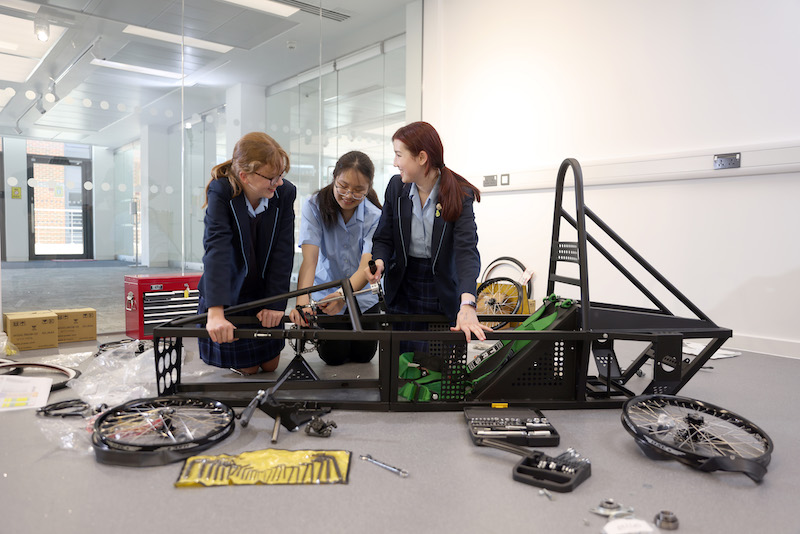Why creativity and innovation are so important
Posted on 25th Nov 2021 in School News, Which School?
Caroline Jordan, Headmistress at Headington School, considers how we can thrive in the digital world.
What differentiates us from robots? This may sound like a silly question but, as technology advances at a sometimes bewildering rate, it could in fact be the most important question of all.
The advance of robots, machine learning and artificial intelligence is already changing the job market immeasurably. Increasingly, jobs which once needed a skilled person in post can be automated. Soon, there may be very few things which machines cannot do at least as well, if not better – and more cheaply – than their human counterparts. The idea that a robot could put you out of a job would seem incredible were it not already happening all over the world.
In education, this is something that needs to be at the forefront of all our minds. If, as PwC predicts, as many as 30 per cent of UK jobs are at risk of being taken over by robots and Artificial Intelligence (AI) by 2030, how do we prepare the children in our charge for this? How does this change what we need to teach and how our students need to learn?
When we educate young people, we need to think not just about equipping them with knowledge and helping them develop as lifelong learners – important though that is – but also it is crucial to think about what comes next. How is what we are teaching them preparing them for the next stage in their educational journey? Are the skills we are encouraging them to develop ones which will mean they are ready for their future – whatever it may hold? What possible applications might the things they are learning at Headington have in the future – and have we truly equipped them to face the unexpected?
There are some skills which remain uniquely human. Creativity and creative thinking appear to be beyond the capacity of artificial intelligence. These are the skills we need to be focussing on developing. We already know how much employers value analytical thinking, innovation, creativity and originality. These differentiate good candidates from excellent ones. In the future, they may be the things which make a human ‘worth’ employing over a robot.
A creative approach – and one which embraced technology wholeheartedly – was critical when schools in the UK and all over the world transitioned to remote learning in 2020. In many parts of the world, teachers are still simultaneously juggling between those learning at home and those in the classroom. Equally, where teachers needed to remain at home, some were teaching remotely to a full classroom back at school. These are changes that no-one would have foreseen. Learning how to think creatively, how to use the existing tools, whatever they may be, to deal with new and unexpected requirements, reiterated the need to place creativity and innovation at the heart of learning.
How, then, do we develop these creative thinking skills? At Headington, this is something we have been thinking about for some time and this year we opened our new Creativity & Innovation Centre: The Hive. This is the new home for Fine Art, Creative Engineering and Design, Sculpture, Photography, History of Art and Fashion Textiles at Headington, as well as a hub for cross-curricular learning with a focus on sustainability, enterprise and technology. As we prepared for its opening, our girls explored artificial intelligence, machine learning and Art, working with the world’s first ultra-realistic AI artist, Ai-Da. As they applied machine learning concepts to gaming, contemplated the lessons from Mary Shelley’s 1818 novel ‘Frankenstein’, investigated AI music composition and looked at AI ethics, the girls considered what it is to be human. In readiness for the opening of the Hive, we ordered a green-powered electric race car which will be built by our Year 8 pupils, but will provide all girls across the School to engage their creative skills in a very tangible way. Work has already started on construction but in addition to this, there will be a host of different curriculum and extra-curricular spin-off projects featuring the car, for example designing the body work, wind tunnel testing in a virtual testing environment, manufacturing the vehicle and seeking sponsorship for the project – engaging a whole host of interdisciplinary approaches and areas for creativity and further study.
It takes a human touch to come up with something new, to take a wider view and to be truly creative. Young minds are uniquely placed to do this – they haven’t yet accepted the orthodox approach and so are really very good at coming up with something original and fresh.
Education has moved some way beyond learning facts and processes by rote and, while there will always be a value to having a good knowledge base, the fact most of us have access to vast quantities of information at our fingertips means this is far less significant than it once was. We all need to think creatively to thrive in a new digital world.
This article first appeared in the 2022 edition of Which School? You can read the new edition here: